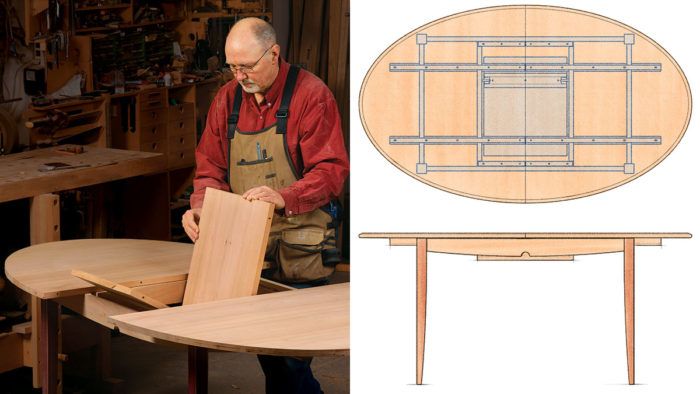Finest Way to Expand a Table
The pivoting leaf of a butterfly table spreads open to create extra table space when guests arrive.

Synopsis: The butterfly table is without doubt the coolest of expanding table designs. Its hinged leaf lies under the tabletop and swings up and open, coming to rest fully expanded on the aprons. The leaf itself is two pieces joined by barrel hinges, connected to the table by a pair of pivot pins. The top can be rectangular, round, oval, or just about any shape. The two halves of the top are attached to T-shaped slides that ride in notches cut into the end aprons, and a pair of cross-stretchers that run between the aprons. A small shelf supports the leaf when it is stored under the table.
When it comes to expanding tables, nothing beats a butterfly table for grace, beauty, and just overall coolness. Its leaf lies under the tabletop and then, like a mechanical wonder, swings up and open, coming to rest fully expanded on the aprons. As the name suggests, it’s like a butterfly emerging from its cocoon—sure to draw a gasp of admiration from your dinner guests and fellow woodworkers, too.

The mechanism is both simple and ingenious. The leaf is two pieces joined by barrel hinges. It is connected to the table by a pair of pivot pins, and stores neatly under the tabletop. Then, as your guests arrive, you slide the top apart, take hold of the top half of the leaf, and pull up. As you do, it rotates on the pins and opens, rising up from beneath the top and unfolding until it rests on the aprons. At that point, you simply push the sides of the top against it and, voila, you have a bigger table. To stow the leaf, you just reverse the process. No struggle, and no loose leaves to store in a closet.
The genius of the mechanism, paired with your craftsmanship, is the perfect way to show how far you’ve come as a furniture maker. It’s not as hard as you might think. Locating the pivot pins properly is the trick, but I’ll show you a trouble-free way to do it. And the mechanism is simple enough to work with just about any type of table. The one I’ve made for this article is fairly conventional—four legs joined to aprons— but you can make one with a pedestal or trestle base. The top can be rectangular, round, oval, or just about any shape. I even have made tops with a serpentine leaf. It works on big tables, too, as long as you beef up the slides (ball-bearing slides are best for big tables) and use more hinges on the leaf.
Straight-Grained Slides Won’t Bind
The basic structure of this table is simple. I joined the legs and aprons with slip tenons. The aprons are curved and the legs tapered, but I keep them square until after I’ve made the butterfly mechanism and routed the mortises. However, the butterfly mechanism does need some explanation. The two halves of the top are attached to slides that ride in notches cut into both the end aprons and a pair of cross-stretchers that run between the side aprons. The slides and notches are T-shaped and work much better than dovetail-shaped slides, which tend to bind when the top is extended.
For the full article, download the PDF below:
From Fine Woodworking #220 with project plans
Fine Woodworking Recommended Products

Bessey K-Body Parallel-Jaw Clamp

Jorgensen 6 inch Bar Clamp Set, 4 Pack

Starrett 12-in. combination square








Log in or create an account to post a comment.
Sign up Log in